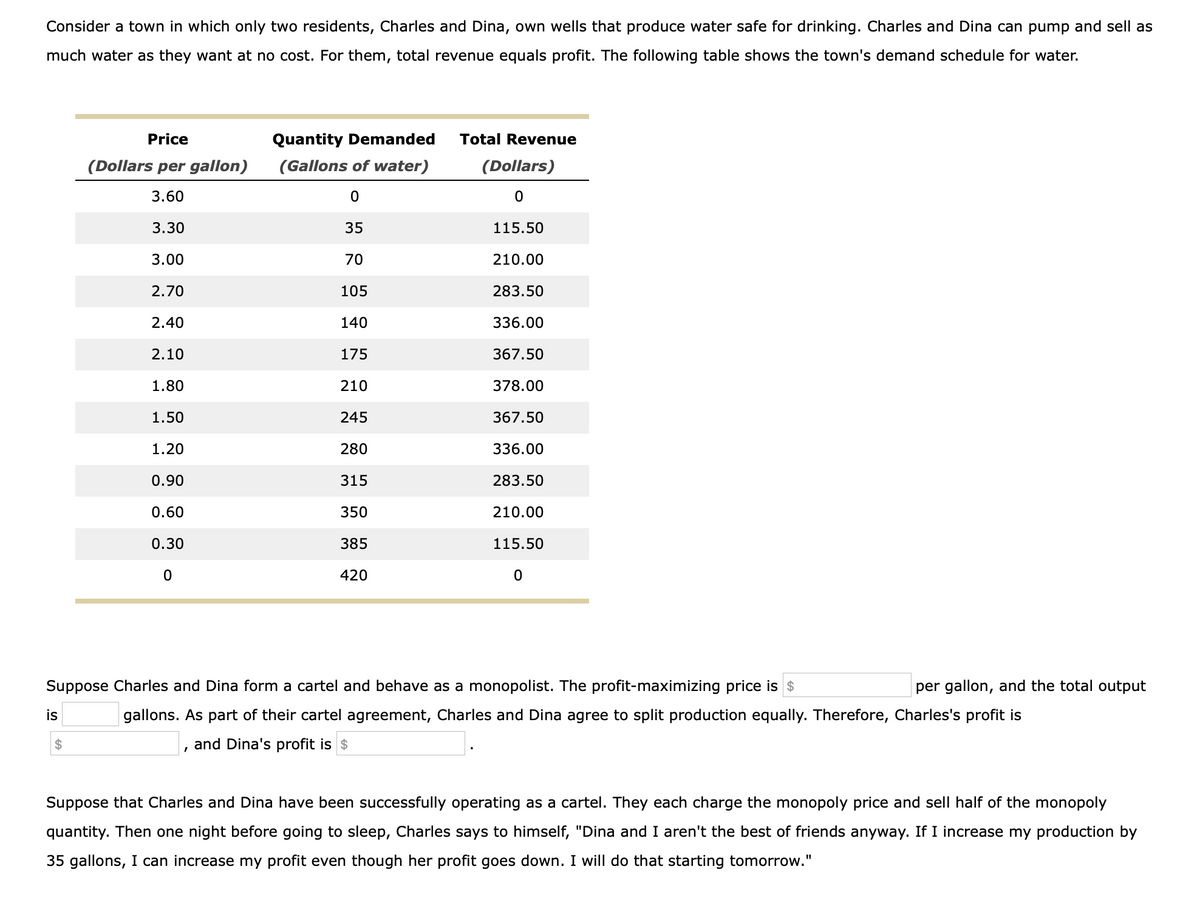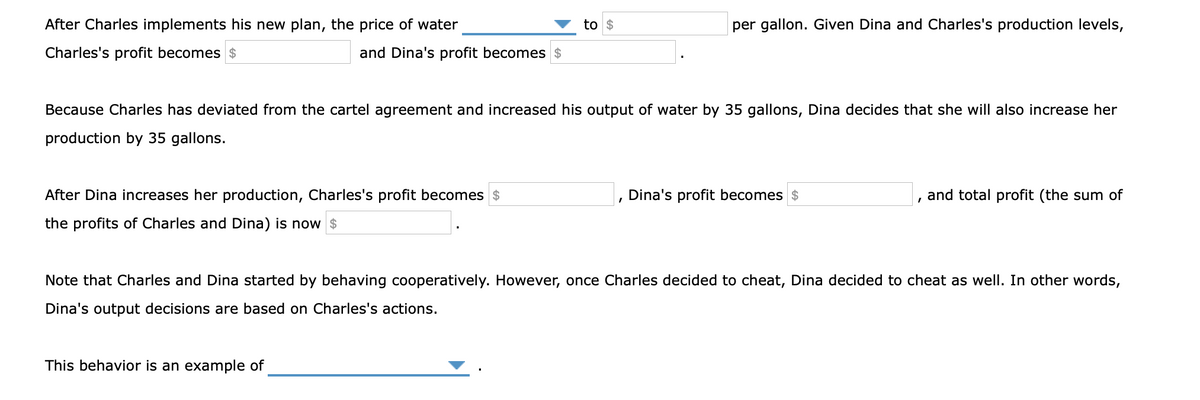Principles of Economics (MindTap Course List)
8th Edition
ISBN:9781305585126
Author:N. Gregory Mankiw
Publisher:N. Gregory Mankiw
Chapter15: Monopoly
Section: Chapter Questions
Problem 8PA
Related questions
Question

Transcribed Image Text:Consider a town in which only two residents, Charles and Dina, own wells that produce water safe for drinking. Charles and Dina can pump and sell as
much water as they want at no cost. For them, total revenue equals profit. The following table shows the town's demand schedule for water.
Price
Quantity Demanded
Total Revenue
(Dollars per gallon)
(Gallons of water)
(Dollars)
3.60
3.30
35
115.50
3.00
70
210.00
2.70
105
283.50
2.40
140
336.00
2.10
175
367.50
1.80
210
378.00
1.50
245
367.50
1.20
280
336.00
0.90
315
283.50
0.60
350
210.00
0.30
385
115.50
420
Suppose Charles and Dina form a cartel and behave as a monopolist. The profit-maximizing price is $
per gallon, and the total output
is
gallons. As part of their cartel agreement, Charles and Dina agree to split production equally. Therefore, Charles's profit is
2$
and Dina's profit is $
Suppose that Charles and Dina have been successfully operating as a cartel. They each charge the monopoly price and sell half of the monopoly
quantity. Then one night before going to sleep, Charles says to himself, "Dina and I aren't the best of friends anyway. If I increase my production by
35 gallons, I can increase my profit even though her profit goes down. I will do that starting tomorrow."

Transcribed Image Text:After Charles implements his new plan, the price of water
to $
per gallon. Given Dina and Charles's production levels,
Charles's profit becomes $
and Dina's profit becomes $
Because Charles has deviated from the cartel agreement and increased his output of water by 35 gallons, Dina decides that she will also increase her
production by 35 gallons.
After Dina increases her production, Charles's profit becomes $
Dina's profit becomes $
and total profit (the sum of
the profits of Charles and Dina) is now $
Note that Charles and Dina started by behaving cooperatively. However, once Charles decided to cheat, Dina decided to cheat as well. In other words,
Dina's output decisions are based on Charles's actions.
This behavior is an example of
Expert Solution
This question has been solved!
Explore an expertly crafted, step-by-step solution for a thorough understanding of key concepts.
This is a popular solution!
Trending now
This is a popular solution!
Step by step
Solved in 3 steps

Recommended textbooks for you

Principles of Economics (MindTap Course List)
Economics
ISBN:
9781305585126
Author:
N. Gregory Mankiw
Publisher:
Cengage Learning

Essentials of Economics (MindTap Course List)
Economics
ISBN:
9781337091992
Author:
N. Gregory Mankiw
Publisher:
Cengage Learning

Principles of Microeconomics (MindTap Course List)
Economics
ISBN:
9781305971493
Author:
N. Gregory Mankiw
Publisher:
Cengage Learning

Principles of Economics (MindTap Course List)
Economics
ISBN:
9781305585126
Author:
N. Gregory Mankiw
Publisher:
Cengage Learning

Essentials of Economics (MindTap Course List)
Economics
ISBN:
9781337091992
Author:
N. Gregory Mankiw
Publisher:
Cengage Learning

Principles of Microeconomics (MindTap Course List)
Economics
ISBN:
9781305971493
Author:
N. Gregory Mankiw
Publisher:
Cengage Learning

Exploring Economics
Economics
ISBN:
9781544336329
Author:
Robert L. Sexton
Publisher:
SAGE Publications, Inc

Managerial Economics: A Problem Solving Approach
Economics
ISBN:
9781337106665
Author:
Luke M. Froeb, Brian T. McCann, Michael R. Ward, Mike Shor
Publisher:
Cengage Learning

Principles of Economics 2e
Economics
ISBN:
9781947172364
Author:
Steven A. Greenlaw; David Shapiro
Publisher:
OpenStax